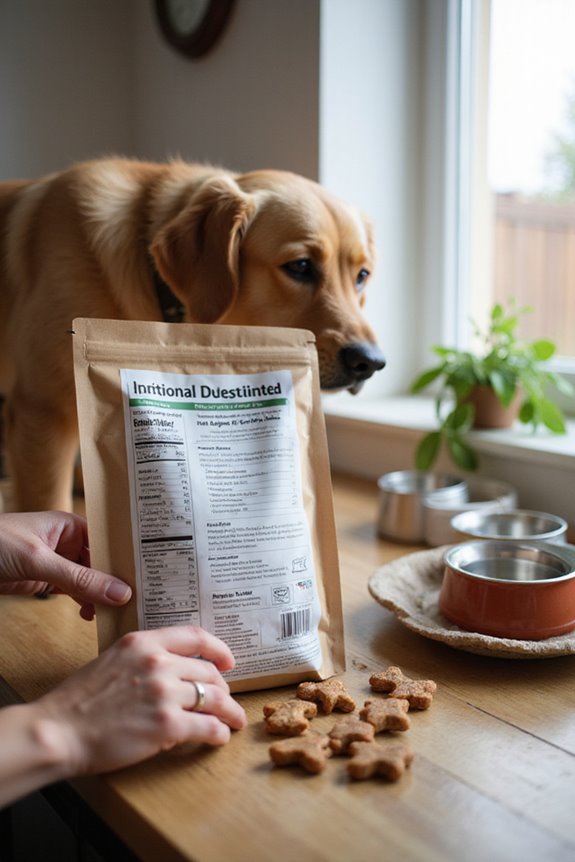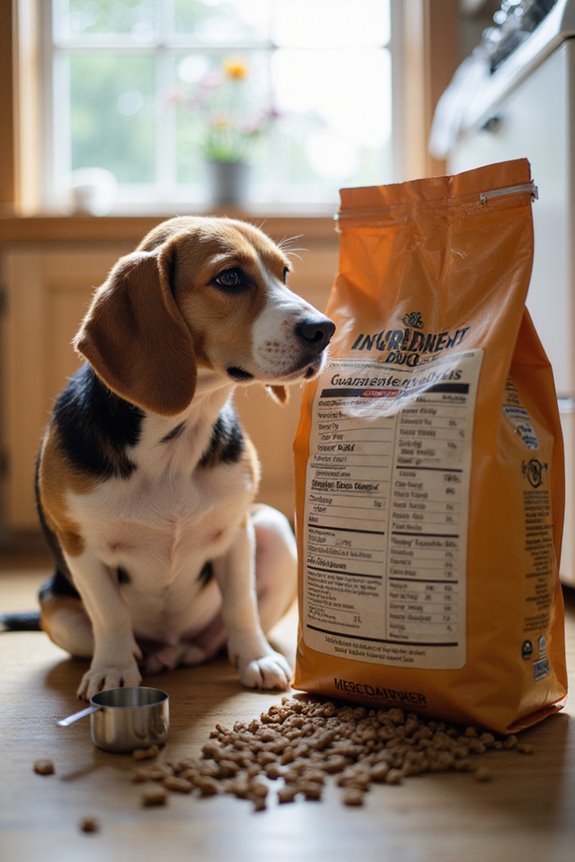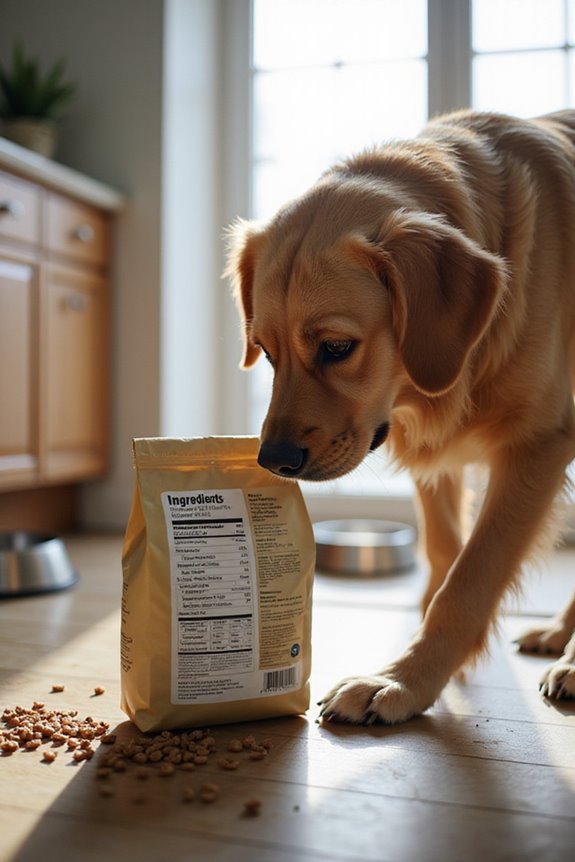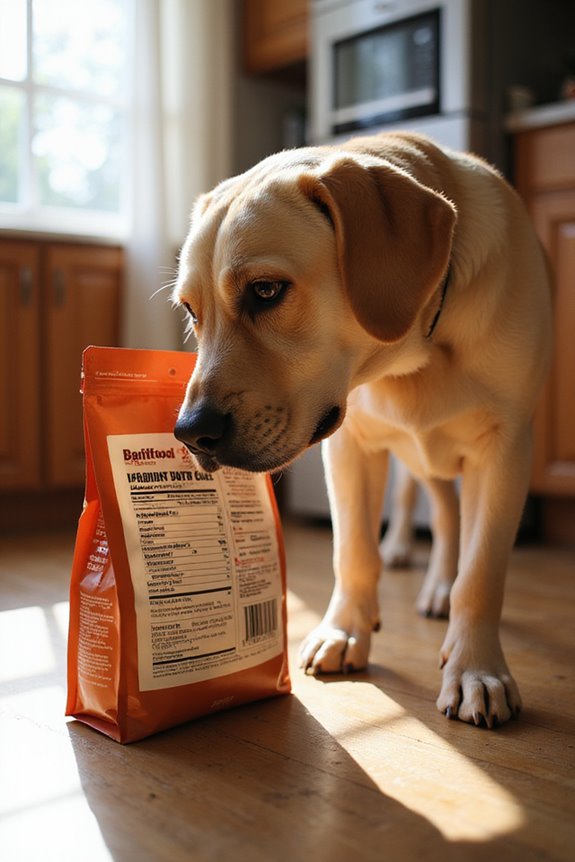To read dog food ingredient labels effectively, start by identifying the product and brand. Ingredients are listed by weight, so prioritize high-quality proteins at the top. Examine the guaranteed analysis for minimum protein and fat percentages and maximum moisture and fiber levels. Look for AAFCO nutritional adequacy statements to guarantee the food meets your dog’s needs. Quality ingredients enhance digestibility and nutrient availability. With these insights, you’ll be better equipped to choose the right food for your pet.
Key Takeaways
- Identify the species and brand name on the label to ensure clarity and transparency regarding the food type and ingredients.
- Examine the ingredient list for specific animal sources and prioritize high-quality proteins listed at the top.
- Analyze the guaranteed analysis for minimum protein, fat, maximum moisture, and fiber percentages to assess nutrient levels.
- Check for an AAFCO nutritional adequacy statement to ensure the product is “Complete and Balanced” for your dog’s life stage.
- Look for whole grains and named fats in the ingredients, avoiding vague terms like “animal by-products” for better nutrition quality.
Understanding Product Identification
When reading dog food ingredient labels, understanding product identification is vital for making informed purchasing decisions. The species designation, such as “Dog Food,” must be clearly stated to prevent any confusion. This clear identification usually appears prominently on the Principal Display Panel (PDP), allowing you to recognize the product’s intended audience.
Brand consistency plays an important role too; the brand name must accurately reflect the ingredient content. For example, if a label says “Chicken Recipe Dog Food,” it should contain at least 95% chicken as per naming rules. This accuracy fosters trust and helps us align our choices with our pets’ nutritional needs. Always verify that labels are clear, avoiding vague claims, to support your decision-making process.
Analyzing the Ingredient List

Analyzing the ingredient list on dog food packaging is essential for evaluating the overall nutritional value and suitability of a product for your pet. When reviewing ingredients, it’s important to understand that they’re listed by weight, including moisture content, which can skew perceptions of nutrient density. For example, whole meat contains up to 70% moisture and may be misleading as a primary protein source compared to concentrated meat meals with around 10% moisture.
Consider these points when analyzing:
- Ingredient sourcing: Look for specific animals to guarantee quality.
- Top ingredients: Evaluate several at once to grasp nutrient sources.
- Protein types: Whole meats, meat meals, and plant proteins offer varied benefits.
A thoughtful analysis guarantees your dog receives peak nutrition.
Interpreting Guaranteed Analysis

Understanding the guaranteed analysis on dog food labels is vital for making informed dietary choices for your pet. This section outlines minimum protein and fat percentages, along with maximum moisture and fiber. These guarantees set nutrient thresholds but don’t reflect exact values; actual protein could exceed minimums. It’s important to take into account moisture impact, as this can skew comparisons between dry and wet foods.
Here are key points to keep in mind:
- Regulatory Compliance: AAFCO mandates these guarantees to guarantee transparency.
- Nutrient Variation: Actual nutrient levels can vary considerably.
- Dry Matter: To compare effectively, look at dry matter analysis, excluding moisture.
Exploring Nutritional Adequacy Statements

Nutritional adequacy statements play a significant role in evaluating the quality of dog food, as they indicate whether a product meets the established nutrient requirements for canine health. These statements are regulated, guaranteeing that the food adheres to nutritional guidelines set by the Association of American Feed Control Officials (AAFCO).
When selecting dog food, look for:
- Complete and Balanced: Suitable for all life stages.
- Specific Life Stage Claims: Tailored for puppies, adults, or senior dogs.
- Specialty Formulas: Designed for specific needs, like weight management.
These statements assure consumers that the food supports their pet’s growth, maintenance, or unique health conditions. Always consult these labels to verify your dog’s nutritional needs are being met effectively.
Deciphering Feeding Directions

When it comes to feeding your dog, knowing how to interpret feeding directions on food labels is essential for ensuring ideal nutrition. First, consider feeding frequency: puppies may need three meals a day, while adult and senior dogs typically thrive on two meals. Consistency here aids digestion.
Next, pay attention to portion adjustments: labels often provide daily portions based on your dog’s ideal weight. These amounts can vary, so adjusting portions based on their activity level, breed, and health condition is necessary.
For accurate feeding, measure food carefully using cups or a scale. If you’re mixing wet and dry food, adjust the portions accordingly to prevent excess calories. Monitoring your dog’s weight can help maintain their health effectively.
Manufacturer Information and Regulations
Steering through pet food labels can seem intimidating, yet knowing the foundational regulations and manufacturer information is essential for making informed choices. Understanding label transparency means being aware of the details that should be included, such as:
- Manufacturer Details: Look for full contact information including name, city, state, and ZIP code.
- Third-Party Production: If it’s produced for a different company, expect phrases like “manufactured for” to clarify responsibility.
- Regulatory Compliance: Labels must meet both federal and state guidelines.
These regulations not only guarantee safety but also maintain accountability. In cases of recalls or safety concerns, this traceability allows us to contact manufacturers effectively, trusting that our furry friends’ food meets stringent standards.
Identifying Quality Ingredients
Understanding manufacturer information and regulations lays the groundwork for making better choices regarding our dogs’ nutrition. When we look at dog food labels, it’s vital to identify quality ingredients.
- Protein Sources: High-quality proteins, listed first, guarantee your dog gets complete amino acids, fundamental for muscle repair. Fresh meats and eggs rank as superior options due to their digestibility and nutrient availability.
- Ingredient Transparency: Whole named ingredients are preferable over vague terms like “animal by-products.” This clarity confirms what we’re feeding our dogs, ultimately affecting their health.
- Carbohydrates and Fats: Opt for whole grains and named fats to support energy and coat health. Additionally, investing in premium foods may reduce future veterinary costs, ensuring your dog maintains optimal health over time.
Recognizing Claims and Labels
Recognizing claims and labels on dog food packaging is crucial for making informed choices about our pets’ nutrition. Understanding label terminology can help us decipher the quality and sourcing of ingredients effectively.
Key elements include:
- Brand and Product Name: They should reflect the primary ingredient accurately.
- Guaranteed Analysis: Provides nutrient composition like protein and fat content.
- Nutritional Adequacy Statement: Indicates if the food meets AAFCO standards for our dog’s life stage.
Ingredient sourcing is essential; terms like “chicken” must indicate the predominant ingredient by weight, ensuring transparency. Additionally, misleading claims about health benefits are prohibited, which helps us avoid false expectations. Being informed allows us to choose food that genuinely supports our furry friends’ health consistently.
Tips for Selecting the Right Food
When it comes to selecting the right food for your dog, it’s essential to contemplate a variety of factors that align with their specific nutritional needs. First, assess your dog’s life stage, activity level, and any health conditions. This helps in determining ideal caloric and nutrient intake.
Next, focus on ingredient sourcing—prioritize whole meats and avoid vague terms like “meat.” Check for beneficial additives, while steering clear of excessive fillers.
Evaluate the guaranteed analysis for proteins, fats, and fibers, ensuring it meets AAFCO standards. Finally, consider feeding directions as guidelines rather than strict rules, and choose products that are cost-effective without compromising quality. Regularly consult your vet for tailored dietary recommendations.
Frequently Asked Questions
How Can I Tell if a Brand Is Reputable?
To tell if a brand’s reputable, I look for brand transparency and clear ingredient sourcing. When they openly share information about their practices, I feel more confident choosing products that truly care about my dog’s health.
What Do the Numbers in the Guaranteed Analysis Mean?
When I examine the guaranteed analysis breakdown, I prioritize understanding the nutritional value explained. It’s essential for me to know the minimum protein and fat percentages to guarantee my dog’s diet’s balanced and healthy.
Are Certain Ingredients Better for Specific Dog Breeds?
I’ve found that while breed-specific nutrition claims sound appealing, ingredient benefits truly depend on individual dogs. It’s essential to prioritize their unique health needs over marketing, ensuring they receive balanced, nutritious meals tailored for them.
How Do I Transition My Dog to a New Food?
Shifting my dog to new food feels like a gentle dance. I prefer a gradual method, taking about 5 to 7 days. It’s essential to monitor their response during this tender duration, ensuring they feel comfortable.
Can My Dog Have Allergies to Dog Food Ingredients?
Absolutely, dogs can have allergies to food ingredients. I’ve seen common food allergies manifest through itchy skin or digestive issues. Identifying allergic reactions quickly helps us find the right diet for our furry friends.




